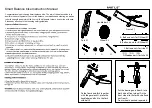
1
Setup - Fox DHX 5.0
setup
SHOCk DHX 5.0
rebound
The rebound adjustment has 14 click range. Adjustments
that are too fast (counter-clockwise adjustment) will produce a
springy ride with excessive kick up of the rear end causing bucking of the
rider. Adjustments that are too slow (clockwise adjustment) will cause
packing of the rear wheel that is identified by a sluggish ride feeling.
slower rebound
- turn the adjuster clockwise
faster rebound
- turn the adjuster counter-clockwise
6
saG setup
Use 25-35% of the shocks stoke for trail riding/freeride
use and 30-40% for downhill use. To determine sag, first measure the
distance between the centers of each shock mounting bolt (eye-to-eye) and
record this number. Make sure you have the correct spring for your weight.
See the spring rate chart.
>2004 AS-X eye-to-eye 8.5”
>2001-03 AS-X eye-to-eye 7.875”.
4
what is pro-pedal?
Pro-Pedal is compression tune that
gives the right amount of low speed compression to filter out
unwanted rider induced bob without sacrificing critical mid
and high speed damping. No flushing through your travel,
no wasted setup time, and no energy sucking suspension
movement, just super efficient pedaling performance ready
for hits of any size.
pro-pedal
The pro-pedal adjustment has a 15 click range of
adjustment. The pro-pedal damping affects the first half of stroke
where most pedal induced bob occurs.
more damping
- clockwise rotation
less damping
- counter-clockwise rotation
bottom-out resistanCe
The bottom-out adjuster has 3 full turns
of adjustment . This adjustment controls the bottoming resistance of
the shock, meaning it controls the compression on final part of the shocks
stroke. The adjuster can be turned by hand or with a 4mm allen key. The
allen key should be placed into one of the holes on the perimeter of the
adjuster.
more resistance
- clockwise rotation
less resistance
- counter-clockwise rotation
Warning:
When the volume adjuster has reached its counter-clockwise
stop limit, continued force on the adjuster may cause damage to the adjuster
mechanism.
boost valve
The DHX 5.0 has an air pressure range of 75-200
psi, and it must be pressurized. The Boost Valve allows the Pro-
Pedal (beginning compression) and the Bottom-Out Resistance (ending
compression) to work seamlessly together. Because of this relationship the
Boost Valve pressure affects both the Bottom-Out Resistance and the Pro-
Pedal Adjustments (see adjustment relation).
lower pressures
(75-100 psi) - will decrease bottoming resistance and
pro-pedal at a given setting.
higher pressures
(110-200 psi) - will increase bottoming resistance and
pro-pedal at a given setting
saG setup
Next, sit on the bike and record the new (eye-to-eye)
measurement. An easy way to calculate sag is to multiply the shock
travel by your desired sag percentage..
5
Warning:
Use of the shock with improper air pressure can cause a loss of
dampening and shock malfunction could occur. Don not attempt to turn the
adjuster with more than 125 psi in the chamber..
setup overview
The DHX 5.0 employs both speed sensitive rebound damping and position sensitive
compression damping. There are three external adjustments that affect the compression and one external
adjustment for the rebound. The three compression adjustments are the Bottom-Out Resistance, Boost Valve
and Pro-Pedal. The Pro-Pedal controls the anti-bob properties of the shock or the first part of the shocks
stroke, the Bottom-Out Resistance affects the end of the shocks stroke, and the Boost Valve damping links
these two adjustments together to create a seamless transition through the entire stroke. The Boost Valve
also de-couples the Pro-Pedal and Bottom-Out Resistance making these adjustments independent on each
other.
1
2
3



































